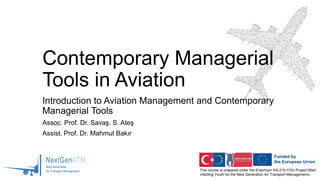This document provides an introduction to aviation management and contemporary managerial tools. It discusses the evolution of civil aviation from the early 20th century developments to modern developments like deregulation. It also outlines some key characteristics of the civil aviation industry, including its capital intensity, global reach, and regulation. Additionally, the document defines managerial tools and outlines some common types used in aviation management, such as planning, communication, financial and leadership tools.























